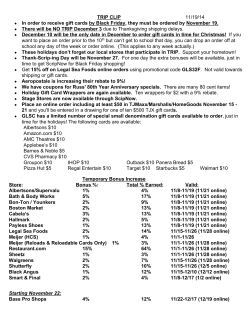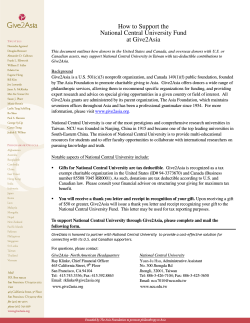
Planned Giving Readiness Checklist
Planned Giving Readiness Checklist By Cathy Mann, Frontier College Does your organization have a compelling need? Will your cause be relevant in 50 or 100 years? Does the board understand why planned giving is important, and are directors supportive? Does the organization have a strategic plan in which planned giving has been identified as a priority? Is the board prepared to make the investment required? Is the board patient enough to wait until a planned giving program matures and begins to show returns? Will board members make their own planned gift, help to identify prospective donors, make time in their agenda for planned giving education, policy making and awareness, and act as ambassadors for the program? Will the CEO promote and, if necessary, defend the planned giving program to the board, work with you to develop the program, and make his/her own planned gift? Will the board allocate resources or make an investment in a person dedicated to planned giving, training and professional development for staff, and training and development for the board? Will the board allocate resources or make an investment in resource material, promotional material, and professional advice when necessary? Can you capture names, addresses and giving history of donors? Are you able to thank donors quickly, sincerely and often for their support? If your organization can meet all these criteria, it’s time to work through the other steps to a fullfledged planned giving program. For further information: Cathy Mann, Executive Director, Frontier College, 416/923-3591, ext 311, Cmann@frontiercollege.ca. Planning is the Operative Word "Planning" is the operative word, and needs to be the guide Nonprofits just testing the waters of planned giving need to develop a work plan to guide them as they go forward, warns Cathy Mann, Executive Director, Frontier College. In Year One, she tells a session of the Canadian Association of Gift Planners conference, staff must first identify a planned giving champion on their board, quietly promote planned giving through existing marketing opportunities, implement the ability to accept gifts of securities, develop policies, procedures and control, work with the board champion to develop evaluation measures, and develop a planned giving club or recognition plan. Year Two is the time to launch the PG club formally, identify who has made a planned gift and invite them to join the club, carry out mass marketing activities, respond to those who give the organization permission to contact them, and begin formal reporting to the board. For the next couple of years, she says, the focus moves to continual evaluation of the program on an ongoing basis, with experience yielding an increasing number of ideas on where and how to grow it. Probably more staff time will need to be applied, and it is important to keep the board informed about planned giving accomplishments, winning directors’ buy-in. Proceeding before implementing Before the plan is developed, Mann says, the organization should run through a readiness checklist, then as it moves on to commitment to pursuing planned giving, it should first focus on bequests (as opposed to other tools of the trade), implement the infrastructure/policies/procedures to accept gifts of securities, and develop gift acceptance policies, administrative procedures, and financial controls. It should set up a planned giving committee or otherwise access professionals to guide and advise how best to proceed. It’s important, she stresses, to get to know the organization’s donors, those who have already made a gift and those who might like to make a gift. The point person on the project should cull the organization’s database looking for prospects and ask board members and senior staff to help identify them. Prospects should be qualified according to the criteria the point person wants to follow; these might include long-time donors, long-time volunteers, clients, or persons of a particular demographic profile. Piggyback on materials To market the program, initially at least, it’s best to piggyback on existing materials, adding planned giving pieces to them. Some initial thinking is required about how donors will be recognized and stewarded, notes Mann. Some possibilities are something like a heritage society, a donor wall, mail/phone/personal visits from staff or volunteers, or special events such as donor recognition teas. Also before actually plunging into the waters, the decision should have been made about how the program will be evaluated – revenue only? expectancies only? number contacted by phone, mail or personal visits? These questions need to be answered so senior staff and the board will know what to expect.
© Copyright 2025


















